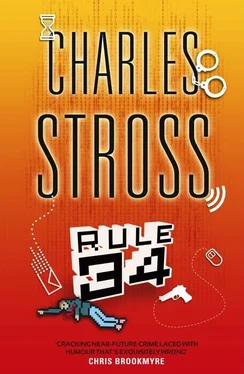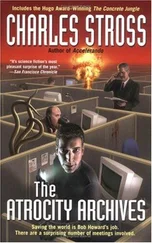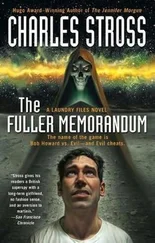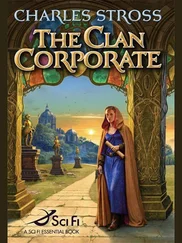“That is very interesting, Doctor. But can I ask you for a moment”—Kemal leans forward—“what do you think of the Singularity?”
MacDonald stares at him for a moment, as if he can’t believe what he’s being asked. “The what—” you begin to say, just as his shoulders begin to shake. It takes you a second to realize he’s laughing.
“You’ll have to excuse me,” he says wheezily, wiping the back of his hand across his eyes: “I haven’t been asked that one in years .” Your sidelong glance at Kemal doesn’t illuminate this remark: Kemal looks as baffled as you feel. “I, for one, welcome our new superintelligent AI overlords,” MacDonald declaims, and then he’s off again.
“What’s so funny?” you ask.
“Oh—hell—” MacDonald waves a hand in the air, and a tag pops up in your specs: “Let me give you the dog and pony show.” You accept it. His office dissolves into classic cyberspace noir, all black leather and decaying corrugated asbestos roofing, with a steady drip-dripdrip of condensation. Blade Runner city, Matrixville. “Remember when you used to change your computer every year or so, and the new one was cheaper and much faster than the old one?” A graph appears in the moisture-bleeding wall behind him, pastel arcs zooming upward in an exponential plot of MIPS/dollar against time—the curve suddenly flattening out a few years before the present. “Folks back then”—he points to the steepest part of the upward curve—“extrapolated a little too far. Firstly, they grabbed the AI bull by the horns and assumed that if heavier-than-air flight was possible at all, then the artificial sea-gull would ipso facto resemble a biological one, behaviourally… then they assumed it could bootstrap itself onto progressively faster hardware or better-optimized software, refining itself.”
A window appears in the wall beside you; turning, you see a nightmare cityscape, wrecked buildings festering beneath a ceiling of churning fulvous clouds: Insectile robots pick their way across grey rubble spills. Another graph slides across the end-times diorama, this one speculative: intelligence in human-equivalents, against time. Like the first graph, it’s an exponential.
“Doesn’t work, of course. There isn’t enough headroom left for exponential amplification, and in any case, nobody needs it. Religious fervour about the rapture of the nerds aside, there are no short-cuts. Actual artificial-intelligence applications resemble us about the way an Airbus resembles a sea-gull. And just like airliners have flaps and rudders and sea-gulls don’t, one of the standard features of general cognitive engines is that they’re all hard-wired for mirrored self-misidentification. That is, they all project the seat of their identity onto you, or some other human being, and identify your desires as their own impulses; that’s standard operating precaution number one. Nobody wants to be confronted by a psychotic brain in a box—what we really want is identity amplification. Secondly—”
Kemal interrupts again. You do a double-take: In this corner of the academic metaverse he’s come over all sinister, in a black-and-silver suit with peaked forage cap, mirrored aviator shades. “Stop right there, please. You’re implying that this, this field is mature? That is, that you routinely do this sort of thing?”
MacDonald blinks rapidly. “Didn’t you know?”
You take a deep breath. “We’re just cops: Nobody tells us anything. Humour us. Um. What sort of, uh, general cognitive engines are we talking about? Project ATHENA, is that one?”
“Loosely, yes.” He rubs at his face, an expression of profound bafflement wrinkling his brows. “ATHENA is one of a family of research-oriented identity-amplification engines that have been developed over the past few years. It’s not all academic; for example TR/Mithras. Junkbot.D and Worm/NerveBurn.10143 are out there now. They’re malware AI engines; the Junkbot family are distributed identity simulators used for harvesting trust, while NerveBurn… we’re not entirely sure, but it seems to be a sand-boxed virtual brain simulator running on a botnet, possibly a botched attempt at premature mind uploading…” He rubs his face again. “ATHENA is a bit different. We’re an authorized botnet—that is, we’re legal; students at participating institutions are required to sign an EULA that permits us to run a VM instance on their pad or laptop, strictly for research in distributed computing. There’s also a distributed screen-saver project for volunteers. ATHENA’s our research platform in moral metacognition.”
“Metacognition?”
“Loosely, it means we’re in consciousness studies—more prosaically, we’re in the business of telling spam from ham.” He shrugs apologetically. “Big contracts from telcos who want to cut down on the junk traffic: It pays our grants. The spambots have been getting disturbingly convincing—last month there was a report of a spearphishing worm that was hiring call girls to role-play the pick-ups the worm had primed its targets to expect. Some of them are getting very sophisticated—using multiple contact probes to simulate an entire social network—big ones, hundreds or thousands of members, with convincing interactions—e-commerce, fake phone conversations, the whole lot—in front of the victim. Bluntly, we’re only human; we can’t tell the difference between a spambot and a real human being anymore without face-to-face contact. So we need identity amplification to keep up.
“The ATHENA research group is working on the spam-filtering problem by running a huge distributed metacognition app that’s intended to pick holes in the spammers’ fake social networks.”
MacDonald magicks up a big diagram in place of the graphs; it looks like a tattered spider-web. “Here’s a typical social network. Each node is a person. They’ve got a lot of local connections, and a handful of long-range ones.” Thin strands snake across the web, linking distant intersections. “Zoom in on one of the nodes, and we have a bunch of different networks: their email, chat, phone calls, online purchases…” A slew of different spider-webs, cerise and cyan and magenta, all appear centred on a single point. They’re all subtly different in shape. “Spambots usually get their networks wrong, too regular, not noisy enough. And we can deduce other information by looking at the networks, of course. You know the old one about checking the phone bills for signs that your partner’s having an affair, right? There are other, more subtle signs of—well, call it potential criminality. Odds are, before your partner snuck off for some illicit nookie, there was a warm-up period, lots of chatter with characteristic weighted phrases—we’re human: We talk in clichés the whole time, framing the narrative of our lives. Or take some of the commoner personality disorders: pre-ATHENA, we had diagnostic tools that could diagnose schizophrenia from a sample of email messages with eerie accuracy. Network analysis lets us learn a lot about people. Network injection lets us steer people—subject to ethics oversight, I hasten to add—frankly, the possibilities are endless, and a bit frightening.”
“Can you give me an example of what you mean by steering people?” Kemal nudges.
“Hmm.” MacDonald’s chair squeals as he leans back. “Okay, let’s talk hypotheticals: Suppose I’m wearing a black hat, and I want to fuck someone up, and I’ve paid for a command channel to Junkbot.D. First, I build a map of their social connections. Then I have Junkbot establish a bunch of sock puppets and do a friend-of-friend approach via their main social networks—build up connections until they see the sock puppets’ friend requests, see lots of friends in common, and accept the invite. Junkbot then engages them in several conversation scripts in parallel. A linear chat-up rarely works—people are too suspicious these days—but you can game them. Set up an artificial-reality game, if you like, built around your victim’s world, with a bunch of sock puppets who are there to sucker them in to the drama. Finally, you use the client-side toolkit to hire some proxies—neds in search of the price of a pint—who’ll hand your target a package and leg it, five minutes ahead of your colleagues, who have received an anonymous tip-off that the quiet guy living at number seventy-six is a nonce.”
Читать дальше












